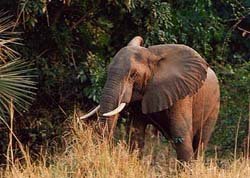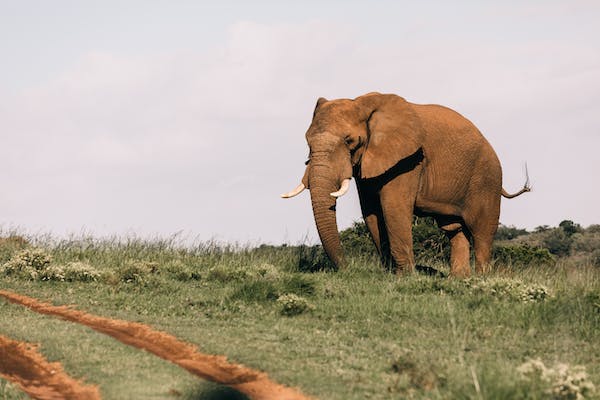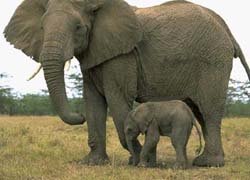It is the largest extant terrestrial animal, with conspicuous large ears, allowing them to reflect any excess heat. This animal possesses a large tusk, which it uses to feed, dig, mark, and fight. Two subspecies occur. The largest African savanna elephant thrives in woodlands and grassy plains while the smaller, darker, African forest elephant can be found in equatorial forests of western and central Africa.
Read further to know more about the African Elephant.
What is an African Elephant?
African Elephants are the largest land animals, thriving in many African countries, and can be found in grassy plains, woodlands, agricultural areas, and wetlands. They are social animals, often seen traveling in herds composed of female elephants or cows, and the juveniles. Meanwhile, adult male elephants or bulls, usually are solitary or aggregate in smaller groups. Despite their massive size, they are herbivores, feeding primarily on herbs, leaves, grasses, and barks.
Its seven levels of classification are as follows:
Kingdom: Animalia
Phylum: Chordata
Class: Mammalia
Order: Proboscidea
Family: Elephantidae
Subfamily: Elephantinae
Genus: Loxodonta
African Elephant Physical Description
African Elephants can grow up to 24.6 feet or 7.5 meters long, standing 10.5 feet or 3.2 meters high at the shoulders, while weighing around 6 tons or 13,230 pounds on average. Males are relatively larger and heavier than females. An elephant bull shot in southern Angola in 1974 stood up to 13 feet or 3.96 feet tall and weighed 10.4 tons or 22,930 pounds.
Their trunk is the upper lip and nose's extension, which they use for handling various items, such as tree branches and food. A common distinguishable feature of African Elephants from their Asian counterparts is two opposing extensions, seemingly like fingers, located at their trunk's end, compared to the latter that only has one. They also have large ears that enable them to reflect any extra heat. The skin is gray and thick, covered with scanty darkish-brown to black hair.
African Elephants boast large tusks, which grow throughout their life. These large modified incisors occur in both sexes, which they use in fights during the mating season, for markings, digging roots, stripping barks, feeding, and protecting themselves from predators. The tusks can weigh from 23 to 45 kilograms or 51–99 pounds and grow about 5 to feet or 1.5 to 2.4 meters long.
Where can they be spotted?
African Elephants occur in much of sub-Saharan Africa, with the African savannah elephants thriving in scrublands, grassy plains, and woodlands. The highest densities can be found in Botswana, Kenya, Tanzania, Zimbabwe, Zambia, and South Africa. Meanwhile, African forest elephants concentrate in western and central Africa, where large patches of dense forest in the continent remain.
Interesting Facts You Should Know About the African Bush Elephant
African Elephants are herbivorous animals, despite their massive size. They feed primarily on leaves, barks, roots, fruits, and other vegetation. They require large amounts of water, which is why a freshwater source is an essential requirement in habitats. These elephants, given their built and power, shape landscapes through seed dispersion, vegetation clearings. Thus, creating new habitats for other species in its range. However, too many individuals in an area may also lead to drastic changes in the habitats, transforming bushvelds into grasslands, affecting other animals.
African Elephants follow an intricate social hierarchy. They aggregate into herds, composed of 10 cows and their juveniles. Several herds may congregate, forming clans. A matriarch or dominant female leads a clan, which can consist of up to hundreds of elephants. They are protective and caring animals and wherein females may raise other offsprings of other females in the herd. Individual members are also assigned to look out for juveniles who wander around or stray too far. Meanwhile, elephant bulls or adult males live singly, or form bachelor groups and only interact with the female herds during mating.
As social animals, African Elephants communicate both verbally and non-verbally. They are very vocal and may squeak, trumpet, rumble, chirp, gurgle. Most of these noises are unheard of by humans, as they produce low frequencies but may travel several kilometers. Communication through body language is also common, such as spreading their ears, raising the trunk, or nodding or shaking the head.
African Elephants are polygynous, which means they have several mates in life. Breeding may happen throughout the year, but peaks during the rainy season. The elephant bull will stay close to the female for a few weeks during mating.
After a gestation period of about 2 years, the elephant cow yields a single baby, nursing the calf for another 2 years after being born. The juveniles will live with the herd until it is 6 years old. Male offspring will then live independently or join a group while the female stays with the herd or clan. Females sexually mature earlier at 10-11 years, while males at 20 years old.
The range of African Elephants has decreased by about 50% due to massive poaching of their ivory, which boasts high values in black markets in Asia and the United States. Moreover, the continued land conversion and the growing human population pose significant threats to the species' overall number. Once around 5 - 10 million individuals roamed across Africa, but today only around 415,000 across the continent. Currently, African Elephants are listed as Vulnerable (VU) under the IUCN Red List of Threatened Species.

WILDLIFE PARKS AND RESERVES WHERE THIS SPECIES IS FOUND:





